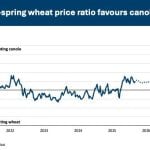The bison industry doesn’t believe its meat will ever replace beef as a red meat staple, but is convinced it can make inroads.
“There are more beef slaughtered in the U.S. in a day than bison in a whole year,” Canadian Bison Association executive director Terry Kremeniuk told an industry meeting in Saskatoon April 16.
He said bison meat is increasingly found at local grocery stores and on restaurant menus worldwide and estimated consumers are eating about five to six ounces of bison meat per person per year.
Read Also

Beef cattle more prone to trace mineral deficiencies
The trace mineral status of our cows and calves is a significant challenge for western Canadian producers and veterinarians.
Kremeniuk would like to see that rise to 10 ounces.
“Eat two bison burgers instead of one,” he said.
The industry’s strategy is to promote bison’s lower fat, calorie and cholesterol and higher iron content to an increasingly health conscious and better educated society.
Baby boomers have more disposable income to spend on premium priced food such as bison while young families look for naturally raised meat free of antibiotics and growth hormone additives.
That’s what bison are all about, said Dieter Pape, president and chief executive officer of the North American Bison Co-operative.
“Organic and natural meat is evolving from a niche market to a lifestyle.”
He said the trick is to persuade consumers to try bison the first time and then introduce them to different cuts.
Hamburger remains the most commonly selected meat.
Pape sees opportunities selling convenience sizes, stir fry portions, steak tips, medallions and brisket as well as promoting bison’s use as an ingredient in casseroles.
A possible recession looming in the United States could drive people to prepare and eat more meals at home.
Bison, still regarded as game meat by chefs, could also compete in restaurants with elk, which has doubled in price.
“The more opportunities consumers have to try bison, the more chances there are for a pleasing experience and a chance they will buy again at restaurants, go to the store and buy it and make it part of their diet,” he said.
The bison industry has previously relied on “grassroots marketing” and word of mouth advertising to promote its products.
A future bison producer checkoff in the United States could allow for more research, education and promotion, such as in-store food tasting demonstrations and teaching chefs about how bison are raised and finished.
“It’s a healthy red meat whose steak cuts are healthier than chicken breasts,” said Pape.
He said bison offers something different to retailers who are challenged to compete with stores like Wal-Mart.
“They can’t do it on price but have to do it on selection or uniqueness.”
Pape expects to see 20 percent annual growth in the U.S. bison market between 2008 and 2011, citing bull prices that have risen to $2.25 in 2008 from $1.35 in 2004.
Kremeniuk called bison a success story, having survived slaughter by hunters at the turn of the century, drought and more recently lower prices and closed international borders during the beef industry’s BSE outbreak.
There are about 400,000 bison in North America, up from less than 1,000 at the end of the 1800s, with the greatest number, 225,000, on the Canadian Prairies. The size of the average herd in Saskatchewan has increased to 560 from 40 in the 1990s.
“They’ve been around for centuries, but the industry is new at 10 years old,” said Mark Silzer, president of the Canadian and Saskatchewan bison associations.
He said the industry will need capital if it is to move forward and supply enough meat and animals to world markets.














